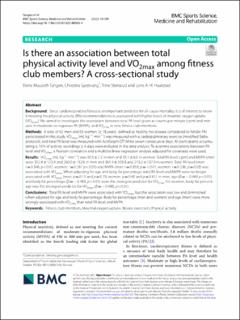Is there an association between total physical activity level and VO2max among fitness club members?: A cross-sectional study
Peer reviewed, Journal article
Published version
Permanent lenke
https://hdl.handle.net/11250/3015172Utgivelsesdato
2022Metadata
Vis full innførselSamlinger
- Artikler / Articles [2119]
- Publikasjoner fra Cristin [1107]
Originalversjon
BMC Sports Science, Medicine and Rehabilitation. 2022, 14(2022), Artikkel 109. 10.1186/s13102-022-00503-4Sammendrag
Background: Since cardiorespiratory fitness is an important predictor for all-cause mortality, it is of interest to know if meeting the physical activity (PA) recommendations is associated with higher levels of maximal oxygen uptake (VO2max). We aimed to investigate the association between total PA level given as counts per minute (cpm) and minutes in moderate-to-vigorous PA (MVPA), and VO2max in new fitness club members.
Methods: A total of 62 men and 63 women (≥ 18 years), defined as healthy (no disease considered to hinder PA) participated in this study. VO2max (mL kg−1 min−1) was measured with a cardiopulmonary exercise (modified Balke protocol), and total PA level was measured with ActiGraph GT1M for seven consecutive days. All participants accumulating ≥ 10 h of activity recordings ≥ 4 days were included in the data analysis. To examine associations between PA level and VO2max, a Pearson correlation and a multiple linear regression analysis adjusted for covariates were used.
Results: VO2max (mL kg−1 min−1) was 40.5 ± 7.2 in men and 35.1 ± 6.0 in women. Total PA level (cpm) and MVPA (min) were 352.4 ± 123.4 and 260.0 ± 132.6 in men and 361.4 ± 103.8 and 273.2 ± 137.0 in women. Total PA level (men: r = 0.346, p < 0.01, women: r = 0.267 p < 0.01) and MVPA (men: r = 0.359, p = < 0.01, women: r = 0.236, p = 0.03) was associated with VO2max. When adjusting for age and body fat percentage, total PA level and MVPA were no longer associated with VO2max (men: p = 0.11 and p = 0.79, women: p = 0.40 and p = 0.61). In men, age (β = − 0.469 p < 0.01) and body fat percentage (β = − 0.483, p < 0.01) were the strongest predictor for VO2max. For women, body fat percentage was the strongest predictor for VO2max (β = − 0.483, p < 0.01).
Conclusions: Total PA level and MVPA were associated with VO2max, but the association was low and diminished when adjusted for age and body fat percentage. Body fat percentage (men and women) and age (men) were more strongly associated with VO2max than total PA level and MVPA.
Beskrivelse
This article is licensed under a Creative Commons Attribution 4.0 International License, which permits use, sharing, adaptation, distribution and reproduction in any medium or format, as long as you give appropriate credit to the original author(s) and the source, provide a link to the Creative Commons license, and indicate if changes were made. The images or other third party material in this article are included in the article's Creative Commons license, unless indicated otherwise in a credit line to the material. If material is not included in the article's Creative Commons license and your intended use is not permitted by statutory regulation or exceeds the permitted use, you will need to obtain permission directly from the copyright holder.
